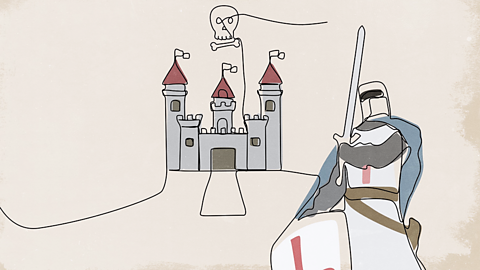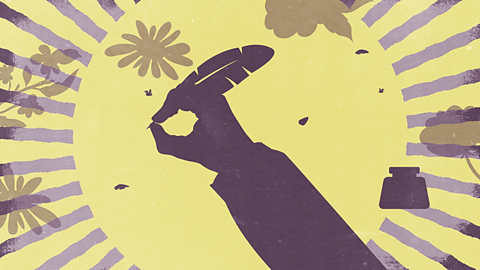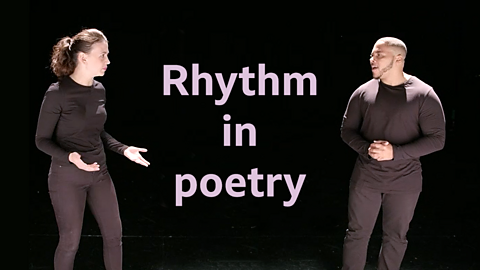Did you know?
Why might a writer need to think about smell?
A writer might need to think about smell because smell is one of the five senses, which are the important ingredients in imagery. What do you think the other four may be?
Introduction to imagery
Imagery can help writers create worlds that readers feel part of.
Key learning points
- How writers use imagery
- The impact of showing, not telling
- How to appeal to a readerтs senses
- Creating layers of meaning
- How to use imagery as shorthand
Video about imagery
A video exploring imagery and how it can create layers of meaning in writing
Imagery is language that creates pictures in our minds and appeals to the senses. You can see some of the techniques in this six-line poem by Alfred, Lord Tennyson:
He clasps the crag with crooked hands;
Close to the sun in lonely lands,
Ringed with the azure world, he stands.
The wrinkled sea beneath him crawls;
He watches from his mountain walls,
And like a thunderbolt he falls.
What do you think the poem is about? Itтs called The Eagle. But could it be about a person? The vocabulary sounds more like a human than an eagle. тCrooked handsт creates an image of a desperate grip. тStandsт sounds more like a human posture than that of a bird of prey.
Is Tennyson using anthropomorphism т giving human characteristics to an animal, because it makes the eagle feel like one of us? He later describes a тwrinkled seaт that тcrawlsт т bringing the water to life. Perhaps making it sound old and weak when compared to the power of the eagle.
Weтre told that тthe eagleт falls like a thunderbolt т Tennyson uses a simile to create an image of power. Lightning can destroy things easily, without warning. This language choice suggests the eagle could be indifferent to its prey, or a powerful human, willing to destroy others for personal gain?
Tennyson describes how distant тthe eagleт is from the ground, which may allude т or imply a reference to т the Greek myth of Icarus. A boy who flew too close to the sun using wings of wax and feathers, until the wax melted, and he plunged into the sea.
And so, when тthe eagleт falls, perhaps Tennyson is alluding to ambition, or bravery or even a recklessness? Is this a suggestion that ambition and hubris can lead to a fall?
Imagery can contain layers of meaning by implying references to other texts, myths and stories.
By using personification, allusion and layered connotations, a poet can create a poem that is rich in meaning. As you analyse other poems, think about the imagery used and explore what the layers of meaning might suggest.
Examples of imagery
Imagery is descriptive writing which appeals to one or more of the five senses.
This extract from EB Whiteтs Charlotteтs Web uses imagery to describe what is left behind after a fair leaves town:
In the hard-packed dirt of the midway, after the glaring lights are out and the people have gone to bed, you will find a veritable treasure of popcorn fragments, frozen custard dribblings, candied apples abandoned by tired children, sugar fluff crystals, salted almonds, popsicles, partially gnawed ice cream cones and wooden sticks of lollipops.
EB White uses lots of imagery that relates to our sense of taste, so the reader is reminded of the foods and flavours associated with the fair, helping the reader to feel connected to the scene.
Imagery can also include figurative language including:
- simileA literary technique where a comparison is made between two things using тasт or тlikeт.
- metaphorMakes a direct comparison by presenting one thing as if it were something else with the characteristic. For example describing a brave person as a lion.
- personificationGiving an object human feelings or actions.
- anthropomorphismGiving human characteristics to an animal.
- allusionHinting at or making reference to a person, place, event or idea.
These type of imagery often use comparisons to create a more vivid impression for a reader.
Impact of showing not telling
Descriptive writing is more interesting if you show your reader what you mean rather than just telling them. For example:
She felt tired.
This example isnтt very interesting, as it tells us how the character feels. Here is it again, but this time showing the characterтs feelings rather than telling:
She yawned and struggled to keep her eyes open.
Read this example from Imbolo Mbueтs Behold the Dreamers:
His throat went dry. His palms moistened. Unable to reach for his handkerchief in the packed downtown subway, he wiped both palms on his pants.
The dry throat and moist palms show us that the character is feeling nervous, even though Mbue doesnтt directly tell us we can still know this from the image created.
Appealing to the senses
There are five main senses: sight, sound, taste, smell and touch. When we write, it is a good idea to appeal to more than one different sense, so that a reader can better visualise what weтre describing.
Click on the image below to explore the five senses
Layers of meaning
Words can have different layers of meaning.
- There is the surface meaning, called the denotation.
- There are also other things which we might associate with the words, called the connotations.
For example, the word тredт denotes the colour red. Red also has many connotations such as danger, anger, love and heat.
Examples of denotations and connotations:
Rose
- Denotation = flower
- Connotation = love, romance
Dove
- Denotation = a small white bird
- Connotation = peace, hope
Writers can use the connotations of words to deepen their use of imagery.
For example, in Shakespeareтs Macbeth, Donalbain says:
Thereтs daggers in menтs smiles.
The word тdaggerт has connotations of violence. Shakespeare is using this connotation to suggest that the character may be in danger and that the тsmilesт are hiding something more unpleasant.
Imagery as shorthand
Writers can use imagery to symbolise deeper meanings:
Sheтd trampled the same dirt roads her entire life; sheтd carved her initials on the bottom of school desks that her mother had once used, and that her children would someday, feeling her jagged scratching with their fingers.
In this example from The Vanishing Half by Brit Bennett, the writer uses the image of initials carved underneath a desk as a shorthand for feeling trapped, because three generations of the same family have used the same school desks and nothing has changed.
Test your knowledge
Play Bitesize secondary games. gamePlay Bitesize secondary games
Have fun playing science, maths, history, geography and language games.

More on Reading poetry
Find out more by working through a topic
- count3 of 8

- count4 of 8

- count5 of 8

- count6 of 8
